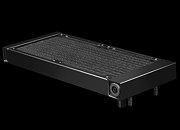Monday, April 15th 2019

DeepCool Intros Castle 240 RGB V2 Cooler with Anti-leak Tech Inside
DeepCool today introduced the Gamer Storm Castle 240 RGB V2 all-in-one closed-loop liquid CPU cooler with an innovation that minimizes the risk of coolant leakages caused due to environmental air-pressure fluctuations. Called DeepCool Anti-leak Tech Inside, the innovation is an elastic pressure-relief bag inside the radiator's reservoir, which has an opening on one end to the air outside. When there is a pressure differential between the air outside and the coolant inside, the elastic bag either contracts or expands, adjusting the reservoir's volume to normalize pressure. DeepCool also extended the design-goal of leakage prevention to the coolant tube design, by using IIR (isobutyline-isopropylene rubber), a material used in slick aircraft tyres that has high elasticity to cope with touchdown. The inner tube is reinforced by fiber-weave sleeving.
This aside, the Castle 240 RGB V2 looks and performs like the original. Its design includes a somewhat tall, cylindrical pump-block with an RGB LED diffuser up top, plumbed to a 240 mm x 120 mm radiator with two included RGB LED fans. The pump's rated noise is 17.8 dBA at its fixed speed of 2,500 RPM. Each of the included fans spins between 500 to 1,800 RPM, pushing up to 69.34 CFM of air, with a noise output under 30 dBA. DeepCool includes retention modules for AMD sockets TR4 and AM4; and Intel sockets LGA2066 and LGA115x. The company didn't reveal pricing.
This aside, the Castle 240 RGB V2 looks and performs like the original. Its design includes a somewhat tall, cylindrical pump-block with an RGB LED diffuser up top, plumbed to a 240 mm x 120 mm radiator with two included RGB LED fans. The pump's rated noise is 17.8 dBA at its fixed speed of 2,500 RPM. Each of the included fans spins between 500 to 1,800 RPM, pushing up to 69.34 CFM of air, with a noise output under 30 dBA. DeepCool includes retention modules for AMD sockets TR4 and AM4; and Intel sockets LGA2066 and LGA115x. The company didn't reveal pricing.





14 Comments on DeepCool Intros Castle 240 RGB V2 Cooler with Anti-leak Tech Inside
The problem of the expansion liquide and gasification greatly increases the pressure on the entire circle and consequently causes spillage. This is a big problem for small enclosed preformens circles, therefore a safety valve is present, which is also present regardless of the regulating body of D.C. own design. But it could be both in one piece, which I would expect today. It is very important to hev decompression space or safety valve when it comes to many large, composite liquid cooleng systems . Regardless of the short-circuit protection, the damage is great , it usually destroys part of the circuit because protection does not cover everything and also does not carry rings was my experience . Gl
IIRC, water, from room temp to boiling is like 4%. What that translates into pressure, (4% more?) no idea...or glycol or w/e is inside. The point is, it doesn't seem like much.
Instead of using a douche bag, why not use a REAL pressure relief valve like the one on your water heater, only smaller & more sensitive, or am I missing something here ???????
I'm with Lex on this, and also calling out the BS :D
And IIRC, DeepCool has had leak problems on their pump housings in the past, Yes ? Maybe they should fix that first....
Plastic tubes can take over this malevolent stretch problem, and most of them lay their system safety on them . The appendix is cheap and every percentage counts, but there is a lot of room for improvement. so that we do not forget the drop in the fan preformace area due to diode decoration .
Nobody installs the safety drain on the safety valve as it is turned down! and everything will be wet ..
??????
Dude, this was never an issue in the first place. As was said earlier, water when increased from ~22C to 100C its volume increases by 4%. A difference of 79C for 4% increase. Let's assume 45C water (hot!)... a difference of 23C...if linear that is ~1.5% difference.
You've repeatedly said this was an issue....buuuut really it isnt.